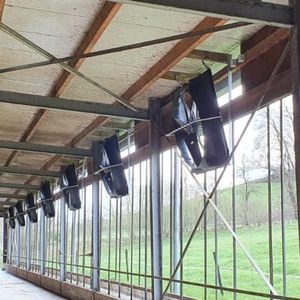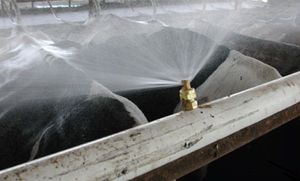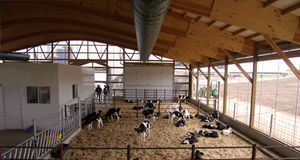
Farm building evaporative cooling pad
Add to favorites
Compare this product
Characteristics
- Applications
- farm building
Description
Pad cooling
Water is being pumped across the pad. The airflow evaporates the water and the air cools down. Temperature can be lowered by 8-15°C, depending on local conditions.
The highly efficient “Aerocool” panels are easy to install and control. Pads are very effective in dry climatic conditions.
Results :
.8-15 degrees lower temperature
.better growth/production on hot days
.better feed conversion
.higher density possible
.lower mortality
.dryer litter
The pad system is installed at the end of the building, with the fans at the opposite end.
First, tunnel ventilation is applied; as soon as the temperature reaches 29 degrees,
the water pump starts and the cooling starts to function.
The highly efficient ABBi-PAd cliMATe sysTeM panels are easy to install and control.
Atomisers, spray nozzles and pads are all very effective in dry climatic conditions. However, in hot and humid regions not all systems are equally suitable. in that case pad cooling systems may be a better solution. A well-installed pad system limits production loss and can be recovered in two or three seasons.
An ABBi-PAd cliMATe sysTeM reduces the air inlet temperature by some 6-12 degrees and under ideal circumstances even more.
This modular system consists of customised elements that when assembled create the housing for the pads. The upper part has a water supply line with holes and special guides for
dividing the water across the pad. The lower part bears the pad and is at the same time the return gutter for the excess water.
Catalogs
No catalogs are available for this product.
See all of Abbi-Aerotech B.V.‘s catalogsRelated Searches
- Air circulation fan
- Farm building fan
- Propeller fan
- Wall-mounted fan
- Farm building air heater
- Ceiling fan
- Galvanised steel fan
- Evaporative cooling pad
- Suspended fan
- Panel fan
- Barn evaporative cooling pad
- Gas air heater
- Fiberglass fan
- Ceiling-mounted air heater
- Farm building ventilation system
- Poultry house air heater
- Suspended air heater
- Radiator
- Barn ventilation system
- Gas infrared heater
*Prices are pre-tax. They exclude delivery charges and customs duties and do not include additional charges for installation or activation options. Prices are indicative only and may vary by country, with changes to the cost of raw materials and exchange rates.










